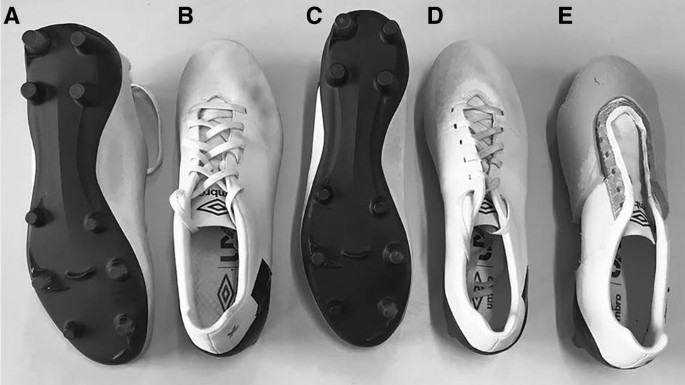Can football boots be used for rugby?
Football and rugby are two of the most popular sports played worldwide, with millions participating in these high-energy games yearly. Both sports require players to have the right equipment and gear, including footwear that provides good grip, support, and protection. But with so many similarities between the two sports, some may wonder if it’s possible to use football boots for rugby or vice versa. In this blog, we will explore this question in detail and look at the differences between football and rugby, the design of football and rugby boots, and the factors to consider when choosing the proper footwear for each sport. So, can football boots be used for rugby? Let’s find out.

Importance of the correct footwear
The correct footwear is crucial for any sport, including football and rugby. Wearing the right shoes can make a massive difference in the player’s performance and safety on the field. One of the primary reasons for wearing the proper footwear is to provide grip and traction on the playing surface. Both football and rugby require sudden changes of direction and quick movements, which can put much stress on the feet and ankles. The right shoes can help reduce the risk of slipping or losing balance, which can cause serious injuries.
Furthermore, proper footwear can support and protect the feet and ankles. Football and rugby involve much running, jumping, and physical contact, which can cause strain and impact on the lower body. Shoes with good padding and support can help absorb shock and protect the feet and ankles from injuries such as sprains and fractures.
The risks of using football boots for rugby
Using football boots for rugby can pose several risks to the player. Football and rugby are different, and their respective footwear is designed to cater to their specific requirements. Here are some risks that may arise when using football boots for rugby:
Lack of Traction:
Rugby involves more physical contact and movement than football, so players require more grip and traction to maintain stability on the field. Football boots have studs that are shorter and fewer in number, making them less suitable for the slippery, muddy conditions of a rugby game.
Increased Risk of Injury:
Rugby players are more likely to suffer from foot and ankle injuries due to intense physical contact and the need to move quickly on the field. Football boots are not designed to provide the same level of protection and support as rugby boots, which can increase the risk of injury.
Reduced Comfort:
Football boots are designed to be lightweight and flexible, with a thinner sole to allow for better ball control. However, rugby players need more padding and support to protect their feet and ankles from the game’s rough tackles and hard impacts. Using football boots for rugby can lead to discomfort and even pain due to the lack of cushioning and support.
Lower Performance:
Football and rugby require different movements, and the wrong footwear can affect a player’s ability to perform optimally. Using football boots for rugby can lead to reduced grip, slower movements, and an increased risk of injury, negatively impacting a player’s performance on the field.
In summary, using football boots for rugby can be risky and is not recommended. Rugby players require specific footwear that provides more grip, support, and protection to accommodate the physical demands of the sport. Football boots can increase the risk of injury, reduce comfort, and lower performance, making it essential for players to invest in appropriate rugby boots.
The advantages of using rugby boots for rugby
Using rugby boots for rugby has several advantages that can enhance a player’s performance on the field. Rugby boots are specifically designed to meet the demands of the sport, providing the following benefits:
Improved Traction:
Rugby boots have more studs that are longer and more widely spaced, providing superior grip and traction on the playing surface. This can help players maintain stability and balance when running, turning, and tackling.
Increased Protection:
Rugby boots have thicker and more durable soles that offer excellent protection to the feet and ankles from the impacts of the game. The boots also have reinforced areas around the toe and heel to provide additional support and prevent injury.
Better Comfort:
Rugby boots are designed with the player’s comfort in mind, with thicker padding and better arch support to absorb shock and reduce pressure on the feet. The boots also have a wider fit to accommodate the player’s feet during the game.
Enhanced Performance:
Rugby boots are designed to provide maximum performance on the field, with features like a lightweight design, better flexibility, and improved ball control. This can help players move faster, change direction quickly, and maintain better ball control during the game.
In summary, using rugby boots for rugby provides several advantages that can improve a player’s performance and safety on the field. Rug boots’ increased traction, protection, comfort, and performance make them essential equipment for rugby players. Investing in high-quality rugby boots designed to cater to the sport’s specific requirements to maintain optimal safety and performance is essential.
The different types of shoes required
Different types of shoes are required for various sports, each designed to cater to the specific demands of the game. Here are the different types of shoes required for some popular sports:
Football Boots:
Football boots are designed with a low-cut ankle and a thin sole to provide better ball control, agility, and speed on the field. They have studs on the bottom to provide traction and grip on the grassy field. They also have different types of studs to cater to different playing conditions, such as hard ground or soft ground.
Rugby Boots:
Rugby boots are designed to offer more protection, grip, and traction than football boots. They have a higher cut, thicker soles, and more durable materials to withstand the game’s physical demands. They also have more studs than football boots for better traction in muddy and slippery conditions.
Running Shoes:
Running shoes are designed for maximum comfort, cushioning, and support during running. They have a lightweight and flexible design to enhance speed and agility. They also have different soles and arch support to cater to different running styles, such as long-distance or trail running.
Basketball Shoes:
Basketball shoes have a high-cut ankle and thick sole to provide stability and support during jumping, landing, and quick movements on the court. They also have better cushioning and shock absorption to reduce the impact on the feet during high jumps and sudden stops.
Tennis Shoes:
Tennis shoes have a flat sole with good lateral support to provide better grip and stability during side-to-side movements on the court. They also have better shock absorption and cushioning to reduce the stress on the feet and ankles during rapid movements and sudden stops.
In summary, different types of shoes are required for different sports to cater to the specific demands of the game. Each shoe is designed to provide better grip, support, comfort, and protection to enhance a player’s performance and safety on the field. Investing in high-quality shoes designed for the specific sport to maintain optimal safety and performance is essential.
Are football and rugby boots the same?
No, football and rugby boots are not the same. Although they share some similarities in their design and function, several differences make them specific to their respective sports.
The primary difference between football and rugby boots is the studs’ number, shape, and length. Football boots generally have fewer and shorter studs compared to rugby boots. The studs on football boots are also usually more conical and evenly distributed to provide better traction on the grassy field. In contrast, rugby boots have more and longer studs, with a mix of conical and bladed shapes, to provide better traction on different playing surfaces, including muddy and slippery conditions.
Another significant difference between football and rugby boots is the level of protection they offer. Rugby boots are designed to provide more protection to the feet and ankles due to the physical nature of the sport, which involves frequent tackling, scrums, and rucks. Rugby boots generally have thicker soles, reinforced toes and heels, and a higher cut to provide better support and prevent injuries. On the other hand, football boots are designed to be lightweight and flexible to provide better ball control and speed, with less emphasis on protection.
What shoes do you use for rugby?
For rugby, it is recommended to use rugby-specific boots that provide better support, traction, and protection for the feet and ankles. Rugby boots have a higher cut, thicker soles, and more durable materials than football boots to withstand the game’s physical demands. They also have more studs than football boots for better traction in muddy and slippery conditions.
Choosing Rugby Boats
When choosing rugby boots, it’s essential to consider the playing surface and weather conditions. Rugby boots are available with studs for different playing conditions, such as hard ground, soft ground, and artificial turf. For example, boots with longer studs are better for wet and muddy conditions, while shorter studs are suitable for firm and dry surfaces.
In addition to the type of studs, other features to consider when choosing rugby boots include the material, weight, and fit. Rugby boots are typically made of leather or synthetic materials, with leather offering better durability and comfort, while synthetic materials offer better water resistance and flexibility. The weight of the boots can also affect performance, with lighter boots providing better speed and agility.
Finally, ensuring that the rugby boots fit correctly and provide adequate support and comfort for the feet and ankles is essential. Rugby boots should fit snugly but not be too tight, with enough room to wiggle the toes and flex the feet. They should also have good arch support and cushioning to absorb shock and prevent injuries.
Should I get soccer or football cleats for rugby?
If you’re planning to play rugby, using rugby-specific boots instead of soccer or football cleats is recommended. While soccer and football cleats may seem similar to rugby boots, they are not designed to provide the same level of support, traction, and protection needed for rugby.
One of the main differences between rugby boots and soccer or football cleats is the studs’ number, shape, and length. Rugby boots generally have more and longer studs with a mix of conical and bladed shapes, providing better traction on different playing surfaces, including muddy and slippery conditions. On the other hand, soccer and football cleats have fewer and shorter studs, generally conical in shape, providing better traction on grassy fields but may not be suitable for the rough and tumble nature of rugby.
Rugby boots also offer more protection to the feet and ankles than soccer or football cleats. Rugby boots have thicker soles, reinforced toes and heels, and a higher cut to provide better support and prevent injuries. Soccer and football cleats are designed to be lightweight and flexible to provide better ball control and speed, with less emphasis on protection.
Therefore, if you’re planning to play rugby, investing in a pair of rugby-specific boots is highly recommended. Rugby boots are designed to provide optimal performance, safety, and comfort on the rugby field. They are specifically engineered to cater to the unique demands of rugby, with features such as the number, shape, and length of studs, level of protection, and durability.
FAQs
Can football boots be used for playing rugby?
While football boots and rugby boots may look similar, they are not designed to provide the same level of support, traction, and protection needed for rugby. Therefore, it is not recommended to use football boots for rugby.
What are the risks of using football boots for rugby?
Using football boots for rugby can increase the risk of injuries, as football boots do not provide the same level of support and protection as rugby boots. Football boots also have different studs, which may not provide adequate traction on muddy and slippery playing surfaces.
Can I wear rugby boots to play football?
While rugby boots are designed to provide better support, traction, and protection for rugby, they can use them for playing football. However, football boots may provide better performance and comfort for football, as they are designed to cater to the unique demands of the sport.
What are the advantages of using rugby boots for rugby?
Rugby boots are designed to provide better support, traction, and protection for playing rugby. They have thicker soles, more durable materials, and more studs than football boots, providing better grip and stability on different playing surfaces. Rugby boots also offer better protection to the feet and ankles, reducing the risk of injuries.
Can I wear football boots if I’m a beginner at rugby?
As a beginner in rugby, it is recommended to use rugby-specific boots to ensure optimal performance and safety on the field. Rugby boots provide better support, traction, and protection, which can help reduce the risk of injuries and improve your overall performance. Therefore, wearing football boots for playing rugby is optional, even if you’re a beginner.




I’m thoroughly pleased with this article! It’s informative, well-written, and provides valuable insights. Keep up the great work.
Thanks Jake.